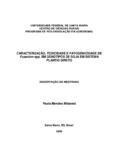| dc.creator | Milanesi, Paola Mendes | |
| dc.date.accessioned | 2017-05-15 | |
| dc.date.available | 2017-05-15 | |
| dc.date.issued | 2009-02-27 | |
| dc.identifier.citation | MILANESI, Paola Mendes. Characterization, toxicity and pathogenicity of Fusarium spp. in soybean genotypes under no tillage. 2009. 91 f. Dissertação (Mestrado em Agronomia) - Universidade Federal de Santa Maria, Santa Maria, 2009. | por |
| dc.identifier.uri | http://repositorio.ufsm.br/handle/1/5000 | |
| dc.description.abstract | The sudden death syndrome (SDS), caused by species of Fusarium, is a disease difficult to control and there are no management techniques and resistant cultivars that give long-term positive results. This study aimed to assess populations of Fusarium spp. and Trichoderma spp. associated to eight soybean genotypes, cultivated under no tillage; to determine if the control of Fusarium varies among isolates of Trichoderma; to identify isolates of Fusarium spp. obtained from different genotypes, and to determine their toxicity and pathogenicity to two genotypes of soybean. Soil and roots were collected from experimental plots located at the Fundação Centro de Experimentação e Pesquisa (FUNDACEP), obtaining isolates of
Fusarium spp. and Trichoderma spp. There were no differences in the population of Fusarium spp. in plants with symptoms of SDS among the different genotypes. For
Trichoderma spp. there was a significant difference among genotypes from plants with and without symptoms of SDS and the genotype CEPS 06006 RR had the biggest population of
the antagonist. In the direct confrontation test, eight isolates of Trichoderma spp. obtained the highest score (1) in relation to the control of Fusarium spp. and isolates of Trichoderma spp. from soil of areas with the SDS symptom were more aggressive. Nine species of
Fusarium: F. avenaceum, F. solani, F. equiseti, F. Acuminatum, F. kyushuense, F. graminum, F. subglutinans, F. verticillioides and F. lateritium were identified. All isolates promoted internerval chlorosis, necrosis and death of seedlings in the toxicity test. In the
pathogenicity test in plants inoculated with the pathogen there was an increase in leaves and roots dry weight and in the number of pods, indicating that there may be species specificity of the species studied in relation to genotype. | eng |
| dc.description.sponsorship | Coordenação de Aperfeiçoamento de Pessoal de Nível Superior | |
| dc.format | application/pdf | por |
| dc.language | por | por |
| dc.publisher | Universidade Federal de Santa Maria | por |
| dc.rights | Acesso Aberto | por |
| dc.subject | Podridão vermelha da raiz | por |
| dc.subject | Trichoderma | por |
| dc.subject | Biocontrole | por |
| dc.subject | Metabólitos tóxicos | por |
| dc.subject | Sudden death syndrome | eng |
| dc.subject | Trichoderma | eng |
| dc.subject | Biocontrol | eng |
| dc.subject | Toxic metabolites | eng |
| dc.title | Caracterização, toxicidade e patogenicidade de Fusarium spp. em genótipos de soja em sistema plantio direto | por |
| dc.title.alternative | Characterization, toxicity and pathogenicity of Fusarium spp. in soybean genotypes under no tillage | eng |
| dc.type | Dissertação | por |
| dc.description.resumo | A Podridão Vermelha da Raiz da soja (PVR), causada por espécies de Fusarium, é uma doença de difícil controle, não existindo técnicas de manejo e cultivares resistentes que
tenham resultados positivos a longo prazo. Assim, este trabalho objetivou quantificar populações de Fusarium spp. e Trichoderma spp. associadas à oito genótipos de soja,
cultivados em sistema plantio direto, observar se o biocontrole de Fusarium spp. difere entre isolados de Trichoderma spp., identificar isolados de Fusarium spp. obtidos de diferentes genótipos e verificar sua toxicidade e patogenicidade a dois genótipos de soja. Amostras de
solo e raízes foram coletadas em parcelas experimentais na Fundação Centro de Experimentação e Pesquisa (FUNDACEP), obtendo-se isolados de Fusarium spp. e Trichoderma spp. Não houve diferença na população de Fusarium spp. em plantas com sintomas de PVR entre os diferentes genótipos. Para Trichoderma spp., houve diferença entre as populações nos genótipos de plantas com e sem sintomas de PVR, tendo o
genótipo CEPS 06006 RR apresentado maior população do antagonista. No teste de confronto direto, oito isolados de Trichoderma spp. obtiveram a melhor nota (um), em
relação a Fusarium spp. e isolados de Trichoderma spp. oriundos de solo em áreas com o sintoma de PVR foram mais eficientes. Foram identificadas nove espécies de Fusarium: F.
avenaceum, F. solani, F. equiseti, F. acuminatum, F. kyushuense, F. graminum, F. subglutinans, F. verticillioides e F. lateritium. Todos os isolados de Fusarium spp.
provocaram clorose internerval, necrose e morte de plântulas no teste de toxicidade. No teste de patogenicidade, em plantas inoculadas com o patógeno houve aumento na massa
seca de parte aérea e de raízes, no número de vagens, indicando que pode haver especificidade das espécies estudadas em relação ao genótipo. | por |
| dc.contributor.advisor1 | Blume, Elena | |
| dc.contributor.advisor1Lattes | http://lattes.cnpq.br/3299996746493028 | por |
| dc.contributor.referee1 | Muniz, Marlove Fátima Brião | |
| dc.contributor.referee1Lattes | http://lattes.cnpq.br/3148312031889388 | por |
| dc.contributor.referee2 | Deuner, Carolina Cardoso | |
| dc.contributor.referee2Lattes | http://lattes.cnpq.br/3029556593136573 | por |
| dc.creator.Lattes | http://lattes.cnpq.br/5448205426679668 | por |
| dc.publisher.country | BR | por |
| dc.publisher.department | Agronomia | por |
| dc.publisher.initials | UFSM | por |
| dc.publisher.program | Programa de Pós-Graduação em Agronomia | por |
| dc.subject.cnpq | CNPQ::CIENCIAS AGRARIAS::AGRONOMIA | por |


